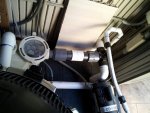Yang,
All I can tell you from what I've read and experienced is that mixing pipe dope and teflon tape can bind things too much in a plastic threaded joint and failures, leaks, and cracks can occur. It is just too much stuff in the threads...the plastic threads. Metal is a different story and much stronger. For me, I now go with all pipe joint compound and no longer use teflon tape as I've experienced too many failures and leaks with teflon tape. Talk to most professional plumbers and they all prefer to use some kind of a pipe dope/compound. This compound is my favorite:
Thread Sealing compounds I use it everywhere and it simply works.
As to the pipe for the pump, it is kind of like selling you a new stove/oven: they never come with a cord because there are simply too many ways/options and plug style one might need or use to get electricity to the appliance!
I should post a pic of the pipe I have heading into my pump. From my Jandy valve, I have a 2.5" female adapter glued to the OUTSIDE of the valve (this is the valve than can take 2" inside or 2.5" outside on its fittings), a 2.5" pvc pipe nipple 12" long screwed into that, then another 2.5" female adapter screwed into the other end of the nipple. Glued into the female adapter is a bushing taking the 2.5" down to 2" threaded. And yep, another 2" pvc pipe nipple is then screwed into the bushing and subsequently screwed into the pump. This crazy thing was at the suggestion of an old-timer at Pentair as he told me that he personally guaranteed the pump would prime in under 10 s if I did all this. He was right! This set-up simply allows a very large volume of water into the pump right away and that is key. That 2.5" pipe's area is over 50% larger than the 2" pipe's area. That makes a big difference.


